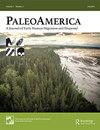反对旧石器时代欧洲人对过去或现在美洲原住民的贡献的遗传学证据
IF 1.7
Q1 ANTHROPOLOGY
引用次数: 3
摘要
现代和古代基因组学最近在美洲人类居住领域引发了新的争论,有时会带来一些奇怪的场景。其中之一是梭鲁特假说。我们认为,不仅支持这一观点的考古证据是相当不确定的,而且也不可能将过去和现在的印第安人的遗传知识与晚更新世跨大西洋迁徙的发生相协调。本文章由计算机程序翻译,如有差异,请以英文原文为准。
Genetic Evidence against a Paleolithic European Contribution to Past or Present Native Americans
ABSTRACT Modern and ancient genomics have recently ignited new debates in the field of peopling of the Americas, sometimes bringing up some odd scenarios. One of those is the Solutrean hypothesis. We argue that not only is the archaeological evidence supporting it rather tentative, but also it is not possible to reconcile what is known about the genetics of past and present Native Americans with the occurrence of a transatlantic dispersal during the late Pleistocene.
求助全文
通过发布文献求助,成功后即可免费获取论文全文。
去求助
来源期刊

PaleoAmerica
Earth and Planetary Sciences-Paleontology
CiteScore
3.70
自引率
0.00%
发文量
15
期刊介绍:
PaleoAmerica disseminates new research results and ideas about early human dispersal and migrations, with a particular focus on the Americas. It fosters an interdisciplinary dialog between archaeologists, geneticists and other scientists investigating the dispersal of modern humans during the late Pleistocene. The journal has three goals: First and foremost, the journal is a vehicle for the presentation of new research results. Second, it includes editorials on special topics written by leaders in the field. Third, the journal solicits essays covering current debates in the field, the state of research in relevant disciplines, and summaries of new research findings in a particular region, for example Beringia, the Eastern Seaboard or the Southern Cone of South America. Although the journal’s focus is the peopling of the Americas, editorials and research essays also highlight the investigation of early human colonization of empty lands in other areas of the world. As techniques are developing so rapidly, work in other regions can be very relevant to the Americas, so the journal will publish research relating to other regions which has relevance to research on the Americas.
 求助内容:
求助内容: 应助结果提醒方式:
应助结果提醒方式:


